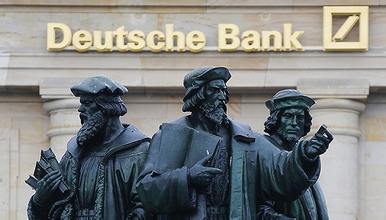德意志银行
Two’s company
两人成伴
Hard questions loom for the new bosses of Germany’s national banking champion
德国最大银行的新总裁们面临着隐隐出现的棘手问题
Dual passports
双重护照
IN THE entrance to Deutsche Bank’s London office is a giant silver ball with a hole in the middle that offers an inverted reflection of the viewer and bank. The sculpture, which is called “Turning the World Upside Down III”, is a fitting metaphor for the changes sweeping the banking industry. Deutsche itself has had a good crisis, eschewing direct help from the German government and rebuilding its balance-sheet to regain its place as the biggest bank in Europe by total assets. Yet its world is turning upside down, too.
德意志银行伦敦分行的入口处有一巨型银球,球中有洞,窥洞中可见观者与德行的倒影。这尊名为“颠倒世界III”的雕塑对于席卷银行业的变革浪潮是一个贴切的暗喻。德意志银行独善其身,很好的度过了危机,他们避开德国政府的直接援助,重建自己的资产负债表,欲借资产总额重归欧洲最大银行之席。然而,德行的世界也正发生着翻天剧变。
The most obvious upheaval is in the executive suite. On June 1st two new co-chief executives, Jürgen Fitschen and Anshu Jain, will take over from Josef Ackermann, who has run the bank for a decade. Mr Fitschen, the boss of Deutsche’s German operations, is a far less controversial figure than Mr Jain, an Indian-born, American-educated British citizen who has propelled Deutsche’s rise in investment banking. Mr Jain’s elevation is a remarkable one in a corporate culture as crusty as Germany’s: most bosses are either German or native German-speakers from Switzerland or Austria. His appointment has also provoked a backlash from an “old guard” within Deutsche who fear the growing influence of the investment bank, which is based almost entirely in London and is staffed largely by non-Germans.
管理层的剧变尤为明显。新任联合首席执行官安舒·贾恩(Anshu Jain)和尤尔根·菲茨岑(Jurgen Fitschen)将于6月1日走马上任,从执掌德意志银行十年的约瑟夫·阿克曼(Josef Ackermann)的手中接过大权。论争议性人物,德行德国业务主管菲茨岑先生远不如贾恩先生。英国人贾恩先生出生于印度,求学于美国,他一手推动了德意志银行在投资银行中的崛起。德国企业文化素来顽固保守,高层大都以德国人或瑞士、奥地利的德语区人士为主,故贾恩先生的高升着实令人惊叹。这次任命同样也激起了德行内部“保守派”的对抗情绪——德行的投行部几乎完全设立在伦敦,员工多为非德裔,投行部日益增大的影响力令“保守派”担忧。

Yet the focus on Mr Jain is a distraction. The bank’s biggest task is not to convince investors that it has the right executives in place—big investors and fund mangers see the new team as more shareholder-friendly than the old one. It is to prove that it has enough capital and liquidity to satisfy regulators and that it can adapt its business model to a topsy-turvy landscape.
然而对贾恩先生的关注是件分心事。 依大投资者和基金管理人之见,新领导团对股东比上任要友好的多,因此德行目前的最大任务不是说服投资者,自己选对了领导人选,而是向他们证明,自己有足够的资本和流动资金来满足监管机构的要求,并能在业界一片颠倒混乱的情况下调整自己的业务模式。
Start with capital Deutsche has total assets of close to 2.1 trillion ($2.7 trillion), and total equity of 56 billion.In terms of simple leverage, the bank has just 1 in equity backing every 38 of assets.
先谈谈资本。德行的资产总额约2.1万亿欧元(2.7万亿美元),权益总额560亿欧元。而就简单杠杆率而言,德行每38欧元的资产仅兑换1欧元股本。
The bank argues that these figures are misleading. By netting off derivatives that offset each other and making a few other adjustments, it calculates its leverage ratio at 21 times, still considerably higher than most peers in Europe and America.
德行辩称上述数据有误导性。在扣掉了可互相抵消的衍生品,进行其他几项微调之后,德行自我估算的杠杆率为21倍,这仍旧远高于多数欧美同类银行。
Like other banks, Deutsche also argues that a simple leverage ratio is not much use in assessing the risks that lenders take.
与其他银行一样,德行也争论道,说简单杠杆率在评估贷方承担的风险时并无大用。
So a second measure to consider is its levels of risk-weighted assets (RWAs), in which the size of the balance-sheet is adjusted to reflect its riskiness.
如此一来,第二种要考虑的评估方法就是银行的风险加权资产等级,即通过资产负债表的规模标准推算贷方的风险。
Using RWAs as a lens is like looking at Deutsche Bank through its lobby sculpture, with the picture turned on its head.
以风险加权资产为透镜,就如同透过伦敦分行的大堂雕塑审视德意志银行,所见景象皆颠倒。
On this view Deutsche is a midsized and reasonably well-capitalised bank, ranking just eighth in size in Europe. Deutsche’s risk-weighted assets are calculated to be a mere 17% of its gross assets, compared with 53% at JPMorgan Chase and 25% at Barclays.
依此观点看,德行就是一家中型、资本相当雄厚的银行,论大小仅位列欧洲第八。德行的风险加权资产仅占其总资产的17%,与之相比,摩根大通为53%,巴克莱银行为25%。
Different accounting standards and the high quality of German corporate and mortgage lending explain some of this gap, but not all. “Deutsche is the most complex institution I have to deal with,” confesses one banking analyst. The question many investors ask is which of these two pictures is more accurate.
不同行的会计准则,高质量的德国企业和德国抵押贷款只能解释这些差距中的部分原委,却无法解释全部。一名银行分析师坦诚的说,“德意志银行是我遇到过的最复杂的机构。”众投资者需要问的问题是,以上两种情况哪一个更贴近事实。
Part of the answer is already being provided by regulators, who are tightening the definitions of what counts as core capital, capping total leverage and carefully scrutinising the risk-weightings that banks apply.
监管机构早已给出了部分解答。近日来,监管机构一直在紧缩核心资本的界定标准,压制全部杠杆作用,并谨慎详核银行上报的风险加权资产。 翻译:王葭苇













